Funnel (ship)
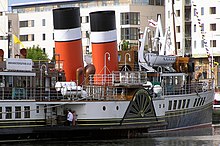

Afunnelis the smokestack orchimneyon ashipused to expelboilersteamandsmokeorengineexhaust.They are also commonly referred to asstacks.
Purpose
[edit]
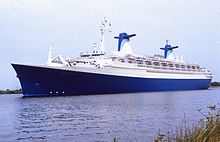
The primary purpose of a ship's funnel(s) is to lift the exhaust gases clear of the deck, in order not to foul the ship's structure or decks, and to avoid impairing the ability of the crew to carry out their duties.
In steam ships the funnels also served to help induce aconvection draughtthrough the boilers.
Design
[edit]Since the introduction of steam-power to ships in the 19th century, the funnel has been a distinctive feature of the silhouette of a vessel, and used for recognition purposes.
Funnel area
[edit]The required funnel cross-sectional area is determined by the volume of exhaust gases produced by the propulsion plant. Often this area is too great for a single funnel. Early steam vessels needed multiple funnels (SSGreat Easternhad 5 when launched), but as efficiency increased new machinery needed fewer funnels.
Merchant ships
[edit]Merchant shipping companies (and particularly liner companies such asCunard Lineand ferries such asRed Funnel) were quick to recognise the publicity value of distinctive funnels, both in terms of shape, number of funnels, and the colours they were painted. In an era when ship hulls were uniformly painted black (to conceal inevitable dirt when loading the ship with coal) and superstructures were white (to control the temperature in the passenger accommodation in hot summers) the funnel was one of the few parts of the ship that a company could use to clearly differentiate its ships from those of its competitors. Each company would have their own "house colours", which were often used in publicity material as well as for recognition, making funnel colours an early form oftrademark.[1]Some companies became so closely associated with their funnel colours that their nickname became ade factocompany name. For example, the shipping line actually registered as 'Alfred Holt & Company' was more widely known as theBlue Funnel Line.The Southampton, Isle of Wight and South of England Royal Mail Steam Packet Company has traded under the nameRed Funnelfor most of its 150+ year history. Other colours such as the red with black stripes of theCunard Lineand the allbuffcolour ofP&Oremain icons of their respective lines and have remained in use for over a century through many changes of corporate ownership.
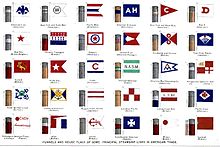
Sometimes the shape of the funnel is used as distinguishing feature rather than just the colour. Cunard fitted ships of itsSaxoniaclass with streamlined round tops to the funnels. Intended as an aerodynamic aid to keep exhaust clear of the deck the modification had very little practical effect but was retained because it made the four ships of the class immediately recognisable and gave Cunard a suitable modern image. There was a trend for 'designer funnels' on liners in the 1960s as fashion and aerodynamic advances combined to offer designers more options that the traditional cylindrical smokestack. TheItalian Linefitted the linersMichelangeloandRaffaellowith funnels topped by flat discs supported on exposed diagonal bracing while P&O'sOrianaandCanberrahad tall, thin funnels with aerofoil cross sections.
In the late 19th and the first half of the 20th century the number of funnels became associated with speed and reliability. For this reason a number of the great liners carried additional false funnels that they did not need.[citation needed]Examples included theWhite Star Line'sRMSTitanic,Hamburg America Line'sSSImperator,and later theFrench Line'sSSNormandie.In most cases there was only a single false funnel placed as the aftermost of the funnels. The false funnels did have more uses than simply aiding aesthetics however - a stoker who survived the sinking of theTitanicescaped the boiler room by ascending the false funnel, the aft funnel ofNormandiehoused the passengers' dog kennels, andDisney Cruise Line'sDisney Magic's forward funnel plays host to a teens-only club.
Naval ships
[edit]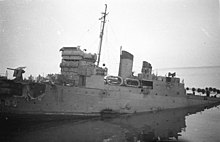
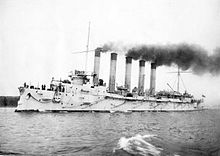
A key part of the deception practiced by ships carrying outcommerce raidingduring both theFirst World WarandSecond World Warwas to disguise their ship's outline, and this included using false funnels or by changing the height or diameter of the actual funnel(s).[2]

Four naval ships with six funnels each were constructed in the late 19th and early 20th centuries: twoItalia-classironclad battleships operated by the Italian Navy from 1885 to 1921, and twoEdgar Quinet-classarmored cruisers operated by the French Navy from 1911 to 1932. Both had their funnels in two groups of three before and abaft of center.
Macks
[edit]Amackis a combined stack and mast, as fitted to some classes of 20th century warships. Although they can reduce top-weight, they have not gained universal popularity due to the problem of exhaust gases corroding electrical aerials and equipment.
References
[edit]- ^TheShipsList."Funnels, Flags, and Night Signals of the Transatlantic Lines".Archived fromthe originalon 29 August 2000.Retrieved10 February2011.
- ^John Asmussen."Admiral Graf Spee in Disguise".Archived fromthe originalon 17 December 2009.Retrieved10 February2011.
